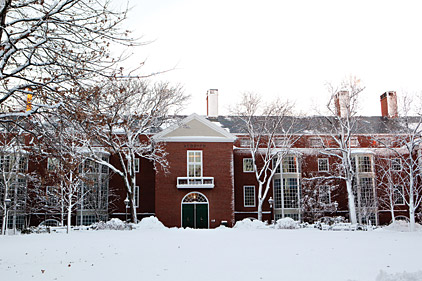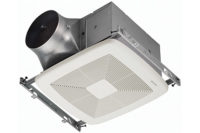
|
| Harvard Business Schools’ Aldrich Hall recently introduced a new HVAC system that improved filtered, conditioned air flow to rates approximately 30 percent greater than those recommended by applicable standards. The system included a MERV 13 filter, which helps remove up to 90 percent of dust particles from the breathing air of these young professionals. (Photo by Evgenia Eliseeva.) |
Aldrich Hall is a 102,825-square-foot classroom serving the Harvard Business School’s MBA program. The building, originally built in 1955, recently completed a three-phase gut renovation. The three stories above grade, with supporting areas below grade, regularly accommodate more than 1,700 students and faculty. The renovation provided an opportunity to update the technological capacity of the classrooms; including desk-integrated polling stations, individual laptop power supplies, and sophisticated audio visual equipment; as well as to improve the building’s lighting and HVAC systems.
Harvard Business School (HBS) has made a significant commitment to reducing its environmental impact and improving the health and comfort of students, faculty, staff, and visitors. Prior to completing Aldrich Hall, Hamilton and Wyss Halls had used the U.S. Green Building Council’s (USGBC) Leadership in Energy and Environmental Design (LEED) green building rating system to achieve gold ratings. While Aldrich did not initially target LEED certification, a comfortable and healthy indoor environment, environmentally friendly materials selection, and improved energy efficiency were project goals from the beginning.
The project involved the renovation of an existing building in an area with excellent access to public transportation, bicycle parking, and within walking distance to a number of community services. More than 50 percent of all pedestrian walkways are shaded by trees to reduce the local heat island effect. The historic fixtures used throughout HBS were retrofitted to minimize up-lighting and improve energy efficiency. A campus-wide exterior lighting master plan was adopted that addresses safety, up-lighting, horizontal light trespass, and energy consumption.
Over time, the improvements produced a 33 percent reduction in domestic water use, 48 percent recycling rate campus-wide, 70 percent energy offset by RECs, and 80 percent C&D waste diversion rate. The building also achieved LEED Silver rating, earning 34 of a possible 69 points on the LEED rating scale.
The Team
Boston architects Baker Design Group were selected to lead the design team for Aldrich Hall. A project manager from William A. Berry & Sons managed the design and construction process. Syska Hennessy Group provided mechanical, electrical, and plumbing engineering services. Shawmut Design and Construction were selected as construction managers for the project and Harvard’s Green Campus Initiative’s New Construction program provided green building consulting services.
Indoor Environmental Quality
To provide a comfortable and healthy indoor environment, Aldrich Hall introduced filtered, conditioned, outside air at rates at least 30 percent greater than those recommended by applicable standards. The MERV 13 filtration is able to remove 89-90 percent of dust particles and has been selected for use in multiple HBS buildings. Dust and other contaminants are also kept out by floor mats at all entrances. To improve occupant comfort, all rooms have multiple lighting scenes and individual temperature controls. Verification of occupant comfort will be done regularly surveying occupants using the built-in polling stations at each location.
Energy Use Monitoring
HBS has a very pro-active facilities engineering department that attends design and construction meetings for all projects. HBS reviews designs for energy efficiency and ease of operations and maintenance and participates in project punch-list activities. Recognizing the benefit of additional utility submeters, HBS has added meters to Aldrich Hall and a number of other buildings, including the recent addition of more than a dozen chilled water submeters. Enhanced metering and sophisticated DDC controls allow HBS to closely monitor energy use and identify opportunities for improvements. Syska Hennessy created an energy model to evaluate the effectiveness of the building’s energy conservation measures. This model will be calibrated based on actual weather and utility data after a year of normal operations. The building’s energy use is dominated by student plug loads and by the substantial AV and lighting needs.
Energy Conservation Measures
All classroom spaces utilize demand control ventilation to regulate outside air intake based on carbon dioxide differentials between the indoor and outdoor environments. All systems with motors 15 horsepower or larger are equipped with variable speed drives to reduce electricity consumption. The building utilizes VFDs for air distribution and heating and cooling hydronic distribution. Additional energy is saved through active chilled beams supplementing the forced air cooling. Chilled beams further raise the temperature of chilled water being sent back to the central plant, improving overall system efficiency. The perimeter corridors of Aldrich are lined with stud alcoves. Lighting in these alcoves is controlled by photosensors to reduce lighting energy.
Solar Powered
HBS has installed a 36.7 kW photovoltaic array on the roof of nearby Shad Hall to produce clean electricity from the sun’s energy. The Massachusetts Technology Collaborative provided grant money for a portion of the project, the rest of which was funded by the Harvard Green Campus Loan Fund. The entrance to the gymnasium has a video link to the roof and a real-time utility display showing electricity production. Shad Hall also produces electricity through a 75kW combined heat and power plant.
Besides producing electricity on-site, HBS offsets much of its energy consumption through the purchase of Renewable Energy Certificates (REC) from Sterling Plant. RECs offer a means to promote renewable energy nationwide by purchasing environmental attributes of renewable energy. HBS has purchased more than one million kWh of RECs from wind produced electricity to offset energy use at Aldrich Hall.
Publication date: 8/27/2012








